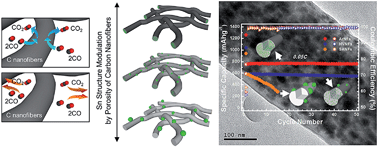Tunable Sn structures in porosity-controlled carbon nanofibers for all-solid-state lithium-ion battery anodes†
Abstract
Volumetric expansion of active materials during lithium (Li) insertion is a critical drawback of Li-alloy anodes and a major bottleneck for their wide adoption in rechargeable batteries. Here, we report on a novel fabrication method of a tin (Sn) fully embedded one-dimensional (1D) carbon (C) matrix which results in minimal volumetric expansion. The 1D C matrix contributes to the buffer role and electron conduction path. This optimized Sn/C structure is enabled by confining the Sn nucleation site and minimizing the outward Sn diffusion originating from stress relaxation. The difference of thermal expansion coefficient between Sn and C derives the stress. The porosity of C nanofibers is a key parameter to modulate the Sn size and dispersion. It is controlled by stabilization and gas–solid reactions between CO (g), CO2 (g), and C nanofibers. The calcination under an Ar environment, which induced the lowest surface area and total pore volume (10.46 m2 g−1 and 0.0217 cm3 g−1), creates an ideal structure of 15 nm sized uniform Sn nanoparticle embedded C nanofibers. It displays a superior anode performance in all-solid-state Li-ion batteries with a capacity of 762 mA h g−1 and coulombic efficiency greater than 99.5% over 50 cycles. Our scheme provides a fundamental impact on anode materials of Li-ion batteries.


 Please wait while we load your content...
Please wait while we load your content...